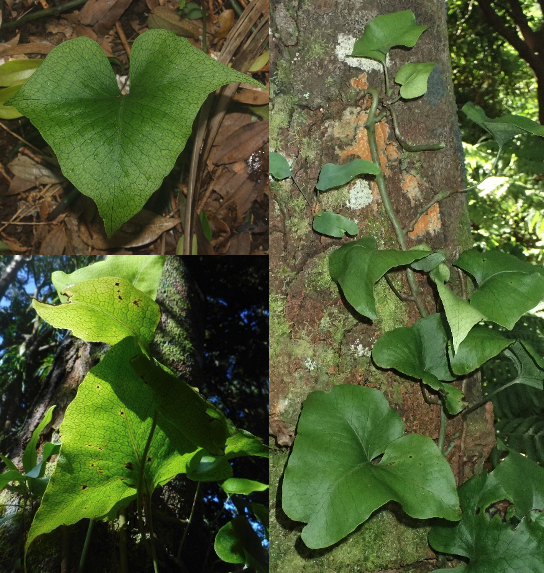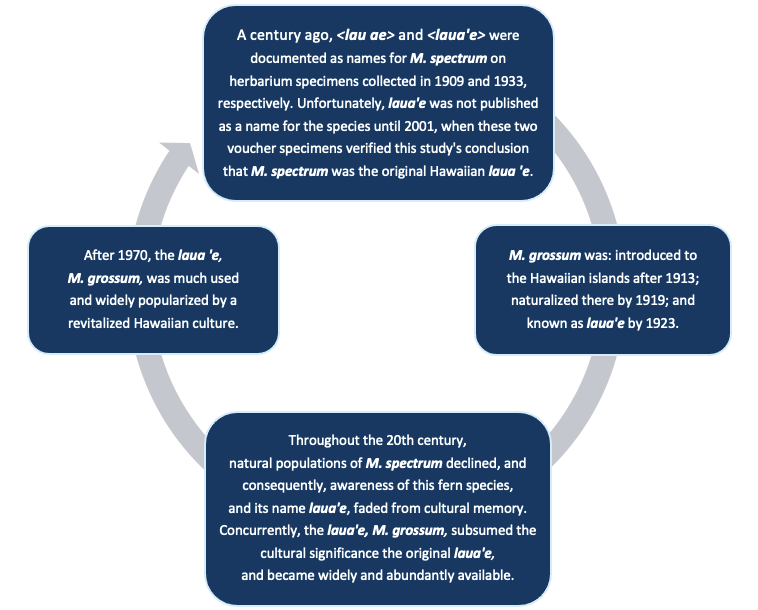The scented Hawaiian laua‘e / Microsorum spectrum and Microsorum grossum / Puanani Anderson-Fung
The scented Hawaiian laua‘e — my two favorite plants:
Microsorum spectrum and Microsorum grossum
Puanani Anderson-Fung (p.k.a. Puanani Anderson-Wong)
The scented Hawaiian laua‘e — my two favorite plants
My love for the laua‘e* — Microsorum grossum (Langsd. & Fisch.) S. B. Andrews — began when I was a child. This fragrant fern grew all over the rocks surrounding the fish pond at the home of my Hawaiian grandmother, where I was raised. To this day, it reminds me of her. Like the scent of the laua‘e, my grandmother’s presence was calming and pleasant, and in her actions, she was also like the plant — tough, resilient, and able to move forward over rough terrain with a certain grace. Little did I know then, that one day I would restore indigenous knowledge of Hawai‘i’s original, native laua‘e fern, Microsorum spectrum (Kaulf.) Copel., the awareness of which had faded from the memory of most Hawaiians during the latter half of the 20th century (Anderson-Wong 2001; Palmer 2003:207; Anderson-Fung 2023).
In the contemporary Hawaiian landscape, it is the laua‘e, M. grossum, that is much sought after, and loved, by Hawaiians, who use the scented fronds as table decorations and for making lei laua‘e — a popular lei ‘garland’, made by incorporating segments of the laua‘e leaf into lei hilo ‘braided lei’, fashioned from leaves of the kī plant, Cordyline fruticosa (L.) A. Chev. This laua‘e is well known in Hawai‘i, where it grows abundantly in many lowland forests and is commonly planted in residential and commercial properties — where it thrives.

Figure 1: M. grossum, the laua‘e hānai ‘adopted laua‘e’ (a term proposed by this author).
Fig. 2. A lei laua‘e worn by Ku‘uleilaua‘e Fung. (Photos by the author.)
Time-honored Hawaiian songs, chants, and stories mention the pervasive fragrance of <lauae>**,
and how it was carried on the winds and mists of the forests.
The word laua‘e also came to mean, ‘beloved, sweet, of a lover’ (Pukui & Elbert 1986),
and was often used metaphorically to refer to persons much loved, as in the phrase:
“O oe e ka Lauae ku kila i ka pali” (Leleiohoku II, c. 1870),
‘You, the Laua‘e standing majestically on the mountain cliff’ (my translation).
Ironically, this deep affection for the laua‘e helped to fuel a not-so-affectionate controversy which emerged in the 1990s, after fern taxonomists reported that M. grossum had not occurred in the Hawaiian Islands prior to 1913 (Wilson 1996:128). Many who knew laua‘e — including well respected members of the Hawaiian community — were adamant that it had been part of our indigenous culture long before 1900, and insisted that these fern specialists were wrong.
As a botanist of Hawaiian descent, I felt compelled to resolve this dispute. I reasoned that since both perspectives were rendered by respected experts, each was likely correct, and the only way this could be true, was if there were two plants named laua‘e — M. grossum and a different species, the memory of which had become obscure over time. Eventually, I solved the mystery in the history of the name laua‘e (Fig. 4), and determined that it had originally identified Microsorum spectrum — a beautiful, fragrant, endemic Hawaiian fern, also known by the Hawaiian name, pe‘ahi.

Figure 2: M. spectrum, the laua‘e maoli ‘native laua‘e’ (a term proposed by this author).
Photos by the author (left) and Clyde Imada (right).
What makes the Hawaiian laua‘e my two favorite plants?
The introduced laua‘e, M. grossum, is one of my favorite plants, because it reminds me of the childhood years I spent at the home of my Hawaiian grandmother, learning to love plants.
Later in life, my affection for this laua‘e fern inspired me to undertake a journey which led me to restore the connection between laua‘e and its original namesake, the native M. spectrum fern, which, as expounded in the Hawaiian literature, was a favorite plant of our ancestors. This makes it an extra-special, doubly favorite plant to me.
The story of Hawai‘i’s two scented laua‘e is an epic tale, pieced together through arduous research. Unfortunately, however, a much greater effort — from many more people — will be required to save M. spectrum from extinction, as it is currently designated an “imperiled taxon” with only about 250 plants remaining in the wild (Keir and Weisenberger 2014).
Hopefully, efforts to conserve the endangered M. spectrum can be invigorated by raising awareness that this species is the laua‘e beloved by our Hawaiian ancestors.

Figure 3: A synopsis of the reconstructed history of the Hawaiian plant name laua‘e
(from Anderson-Fung 2023)
Notes
*Italics are used for emphasis and contrast of all kinds, including the purely practical purpose of informing the reader that certain italicized words are from a language different than that of the narrative. Their use here does not in any way suggest that a word is foreign (Trask 1997). Aldus Manutius, a famous Venetian printer, invented the type and introduced it in 1501 (Harper 2021) when he published a book of poems by the Italian poet Virgil, and printed it the Italic font, to showcase his beloved, native Italian language, and distinguish it from other languages published in Venice at that time.
** Indigenous plant names are spelled as they were by their sources. Occasionally, angle brackets, ‘< >’, are used to emphasize that the name was spelled as originally rendered. These spellings may lack glottal stops and macrons, which were not consistently used to spell Hawaiian words before 1945 (Schütz 1994).
Literature
Anderson-Fung, P. 2023. The tale of Hawai‘i’s two scented laua‘e, Microsorum spectrum and Microsorum grossum: Solving the mystery of their history and restoring indigenous knowledge, using the synergism of Linnaean and Polynesian taxonomy. Ethnobotany Research and Applications 26, 1–43. Retrieved from https://ethnobotanyjournal.org/index.php/era/article/view/5229
Anderson-Fung, P. and K. Maly. 2002. Hawaiians and Ecosystems: How Growing Plants for Lei Helps to Preserve Hawai‘i’s Natural and Cultural Heritage. In: Growing Plants for Hawaiian Lei: 85 Plants for Gardens, Conservation, and Business, J. R. Hollyer, et al., 177–205. Honolulu: CTAHR, University of Hawai‘i. https://www.ctahr.hawaii.edu/oc/freepubs/pdf/rm-16.pdf
Anderson-Wong, P. 2001. Returning the beloved plant laua‘e maoli to the Hawaiian people and clarifying the role of the invasive alien laua‘e (Phymatosorus grossus) holds significance for cultural and natural conservation efforts. https://ethnobotany.org/home/awards/edmund-h-fulling-award.html
Andrews, L. 1865. A Dictionary of the Hawaiian Language. (Reprint 1974). Rutland, Vermont: Charles E. Tuttle Company.
Beckman, J. 2008. Science or poetry? Vernacular plant names and binary nomenclature in Sweden around 1900. The Linnean Newsletter and Proceedings of the Linnean Society of London, Special Issue 8: 55–62.
Harper. 2021. Italic. Etymonline. https://www.etymonline.com/italic.
Keir and Weisenberger. 2014. Hawai‘i Strategy for Plant Conservation. Laukahi.org: Hawai‘i Plant Conservation Network. http://laukahi.org/wp-content/uploads/2016/02/Hawaii-Strategy-for-Plant-Conservation_AUG-28-2014.pdf
Leleiohoku II, W. P. No date. [c. 1870s] Kau mea Hoinainau Song (He Inoa no Keelikolani). [Original sheet music] Bishop Museum Archives, MsCase 4 M42. Honolulu: B. P. Bishop Museum.
Nesbitt M. 2014. Use of herbarium specimens in ethnobotany. In: Salick MJ, Konchar K, Nesbitt M. (eds). Curating biocultural collections: A handbook. Royal Botanic Gardens, Kew, Surrey, U.K., Distributed by University of Chicago Press, U.S.A., Pp. 313–328.
Palmer, D. D. 2003. Laua‘e. In: Hawai‘i’s Ferns and Fern Allies, p. 207. Honolulu: University of Hawai‘i Press.
Pukui, M. K. and S. H. Elbert. 1986. Hawaiian Dictionary. Honolulu: University of Hawai‘i Press.
Quammen, D. 2007. A passion for order. National Geographic Magazine, June 2007.
http://ngm.nationalgeographic.com/print/2007/06/linnaeus-name-giver/david-quammen-text.
Schütz, A. J. 1994. The voices of Eden: a history of Hawaiian language studies. Honolulu: University of Hawai‘i Press.
Trask, L. 1997. Italics. Sussex, UK: Dept. of Informatics, University of Sussex. http://www.sussex.ac.uk/informatics/punctuation/misc/italics
Wagner, W. H. Jr. 1950. Ferns naturalized in Hawaii. Occasional Papers of the Bernice P. Bishop Museum 20(8): 95–121.
Wilson, K. A. 1996. Alien ferns in Hawai‘i. Pacific Science 50(2): 127–141.
About the author
Nani is an ethnobotanist and conservationist of Hawaiian–European descent, working to preserve and restore native Hawaiian plant communities and indigenous Polynesian botanical knowledge. As a teenager, she rescued and restored a 1.5 acre garden of native Hawaiian plants on the Kapālama campus of Kamehameha High School before heading to college. She has conducted ecological field research and conservation service on six Hawaiian islands. Her dissertation research uses Hawaiian language, comparative Polynesian linguistics, and the synergy of global Linnaean and indigenous Polynesian taxonomy to restore indigenous knowledge and refine our understanding of Hawaiian and Polynesian plant names and their etymologies.
The Society for Ethnobotany is open to researchers, practitioners, and enthusiasts of ethnobotany and economic botany.
The 2026 SEB Annual Meeting will take place in Montpellier, France, from May 31-June 4th!
If you have an interest in ethnobotany or economic botany you can become a member of the Society for Ethnobotany.
If you are a member of the Society for Ethnobotany and would like to contribute a Favorite Plant please contact Blair Orr, blairorr@ymail.com. (Note: ymail, not gmail.)
